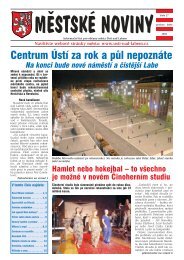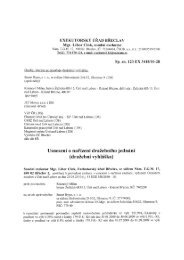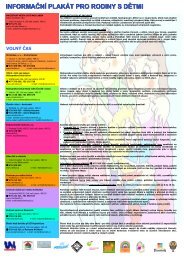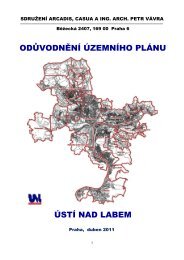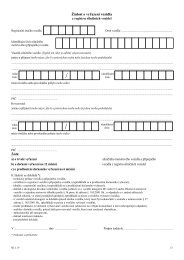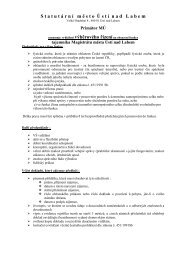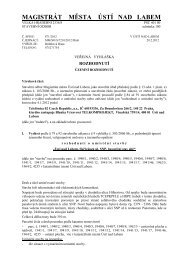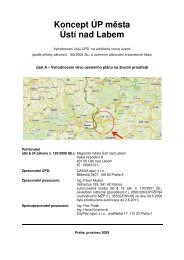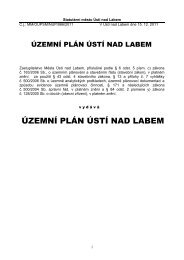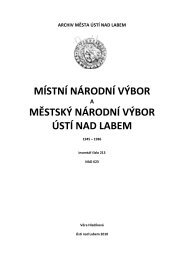Historie a památky města Ústí nad Labem History and monuments of ...
Historie a památky města Ústí nad Labem History and monuments of ...
Historie a památky města Ústí nad Labem History and monuments of ...
Erfolgreiche ePaper selbst erstellen
Machen Sie aus Ihren PDF Publikationen ein blätterbares Flipbook mit unserer einzigartigen Google optimierten e-Paper Software.
46<br />
CZ ENG DE<br />
vatelstva z <strong>města</strong> odsunuta a tvořili již jen necelá 4% z celkového<br />
počtu obyvatel oproti téměř 78% před válkou.<br />
Správu <strong>města</strong> po válce převzal místní národní výbor, jehož <strong>nad</strong>řízeným<br />
orgánem byla okresní správní komise (OSK), později<br />
okresní národní výbor. Složení OSK odpovídalo novému rozložení<br />
politických sil v okrese, což posílilo pozici KSČ. Její postavení<br />
potvrdily i volby do Národního shromáždění v roce 1946,<br />
kdy získala v <strong>Ústí</strong> <strong>nad</strong> <strong>Labem</strong> <strong>nad</strong>poloviční většinu hlasů. Únorové<br />
události proběhly ve městě v režii komunistů – 24. února<br />
1948 zorganizovali generální stávku, které se zúčastnily všechny<br />
ústecké závody. Začaly vznikat akční výbory Národní fronty,<br />
byli perzekuováni členové demokratických stran, duchovní a<br />
mnozí další. Ještě v roce 1948 se uskutečnily dva zinscenované<br />
soudní procesy; veřejné „šmelinářské“ a ostatní procesy se<br />
konaly v závodní jídelně Setuzy. Jednou z obětí komunistické-<br />
ted in 1954 in Prague.<br />
38<br />
national committee, the supreme<br />
body <strong>of</strong> which was the<br />
district administration commission<br />
(OSK), later re-named the<br />
district national committee. The<br />
composition <strong>of</strong> the district administration<br />
commission reflected<br />
the new distribution <strong>of</strong> political<br />
forces in the district, which<br />
strengthened the position <strong>of</strong> the<br />
communist party (KSČ). This<br />
was also confirmed by the election<br />
for the National Assembly<br />
in 1946, with an absolute majority<br />
<strong>of</strong> votes acquired in <strong>Ústí</strong> <strong>nad</strong><br />
<strong>Labem</strong>. The February events in<br />
the town took place under the<br />
control <strong>of</strong> the communists – on<br />
24 February 1948 a general strike<br />
was organised by them, in<br />
which all <strong>Ústí</strong> plants <strong>and</strong> businesses<br />
took part. Action committees<br />
<strong>of</strong> the National Front were<br />
created, members <strong>of</strong> democratic<br />
parties were persecuted as well<br />
as clergymen <strong>and</strong> many others.<br />
In 1948, two show trials were<br />
organised; these open “blackmarketeer”<br />
trials <strong>and</strong> others took<br />
place in Setuza´s canteen. One<br />
<strong>of</strong> the victims <strong>of</strong> the communist<br />
regime was also a native <strong>of</strong><br />
<strong>Ústí</strong>, František Zajíček, execu-<br />
The air raids, interrupted cultural development, complicated<br />
post-war settlement, changes to the structure <strong>of</strong> the population<br />
<strong>and</strong> the politics <strong>of</strong> the ruling communist party considerably<br />
affected the urban face <strong>of</strong> the city between 1952 <strong>and</strong> 1990. Particularly<br />
the historic centre <strong>of</strong> the city went through insensitive<br />
demolition <strong>and</strong> rebuilding in the 1970´s <strong>and</strong> 80´s, which gradually<br />
enclosed the town by neighbourhoods made <strong>of</strong> reinforced<br />
concrete. The growing industrial production represented by the<br />
huge number <strong>of</strong> businesses had a negative impact on the environment.<br />
What contributed to this situation to make it even<br />
worse was more <strong>and</strong> more intensive open cast coal mining in<br />
the city surroundings from the 1960´s. The bad condition <strong>of</strong> the<br />
environment became part <strong>of</strong> the demonstrated resistance to<br />
the current regime at the end <strong>of</strong> the 1980´s.<br />
nüber der deutschen Bevölkerung eine Reihe von Maßnahmen<br />
angewendet, welche bereits im Košický vládní Programm<br />
(Kaschauer Regierungsprogramm) im April erlassen wurden.<br />
Diese Maßnahmen wurden von einer Menge Exzesses begleitet,<br />
die nach der bis heute unerklärten Explosion des Lagerhauses<br />
am 31. Juli 1945 in Krásné Březno (Schönpriesen) kumulierten.<br />
Beim folgenden sogenannten Aussiger Massaker kamen<br />
etwa 100 Deutsche ums Leben. Bis zum Ende des Jahres 1946<br />
wurde dann die meiste deutsche Bevölkerung aus der Stadt<br />
vertrieben und bildete dadurch nur noch nicht ganz 4% der<br />
gesamten Bewohnerzahl im Vergleich mit nahezu 78% vor dem<br />
Krieg.<br />
Die Stadtverwaltung wurde nach dem Krieg vom Ortnationalausschuss<br />
übernommen, dessen übergeordnetes Organ die<br />
Bezirksverwaltungskommission (OSK) war, später Bezirksnationalausschuss.<br />
Die Zusammensetzung der OSK entsprach der<br />
neuen Verteilung politischer Mächte im Bezirk, was die Position<br />
der kommunistischen Partei KSČ verstärkte. Ihre Position<br />
wurde auch bei der Wahl für die Nationalversammlung im Jahre<br />
1946 bestätigt, als sie in <strong>Ústí</strong> <strong>nad</strong> <strong>Labem</strong> die absolute Mehrheit<br />
der Stimmen gewann. Die Ereignisse im Februar verliefen in<br />
der Stadt unter Regie der Kommunisten – am 24. Februar 1948<br />
veranstalteten sie einen Generalstreik, an dem alle Aussiger<br />
Betriebe teilnahmen. Es entst<strong>and</strong>en Aktionsausschüsse der<br />
Nationalfront, Mitglieder der demokratischen Parteien sowie<br />
auch die Geistlichen und viele <strong>and</strong>ere wurden verfolgt. Noch im<br />
Jahre 1948 f<strong>and</strong>en zwei inszeniert Gerichtsprozesse statt;<br />
öffentliche „Schwarzhändlerprozesse“ und <strong>and</strong>ere Prozesse<br />
f<strong>and</strong>en in der Betriebskantine von Setuza statt. František Zajíček<br />
– der Bewohner von <strong>Ústí</strong> – wurde zu einem der Opfer des<br />
kommunistischen Regimes. Er wurde im Jahre 1954 in Prag<br />
hingerichtet.<br />
Die Luftangriffe, die unterbrochene kulturelle Entwicklung, komplizierte<br />
Nachkriegsbesiedlung, Änderung der Struktur der<br />
Bevölkerung, sowie auch die Politik der regierenden kommunistischen<br />
Partei KSČ, das alles hatte in den Jahren 1952-1990<br />
einen starken Einfluss auf das urbanistische Aussehen der<br />
Stadt. Vor allem der historische Stadtkern litt enorm, welcher in<br />
den 70er und 80er Jahren gefühllos verändert wurde und sich<br />
allmählich in einer „Einschließung“ von Siedlungen mit Wohnblöcken<br />
bef<strong>and</strong>. Die wachsende industrielle Produktion in einer<br />
Menge von Betrieben zeigte sich sehr negativ an der Umwelt,<br />
was seit den 60er Jahren der immer intensivere Braunkohletagebau<br />
in der Umgebung der Stadt noch verschlimmerte. Der<br />
schlechte Zust<strong>and</strong> der Umwelt wurde am Ende der 80er Jahre<br />
zum Best<strong>and</strong>teil des Widerspruchs gegen das bestehende<br />
Regime.



